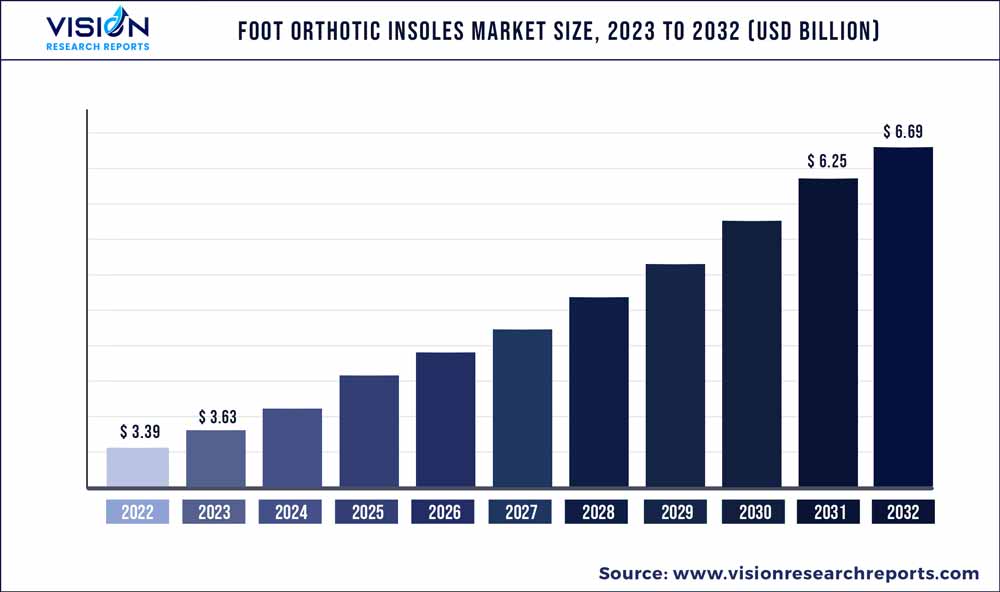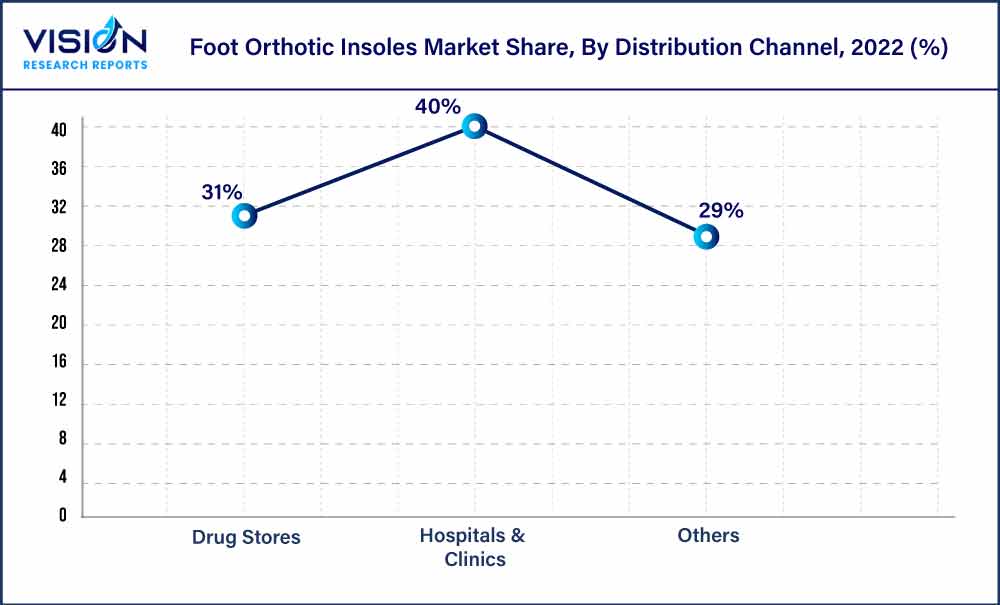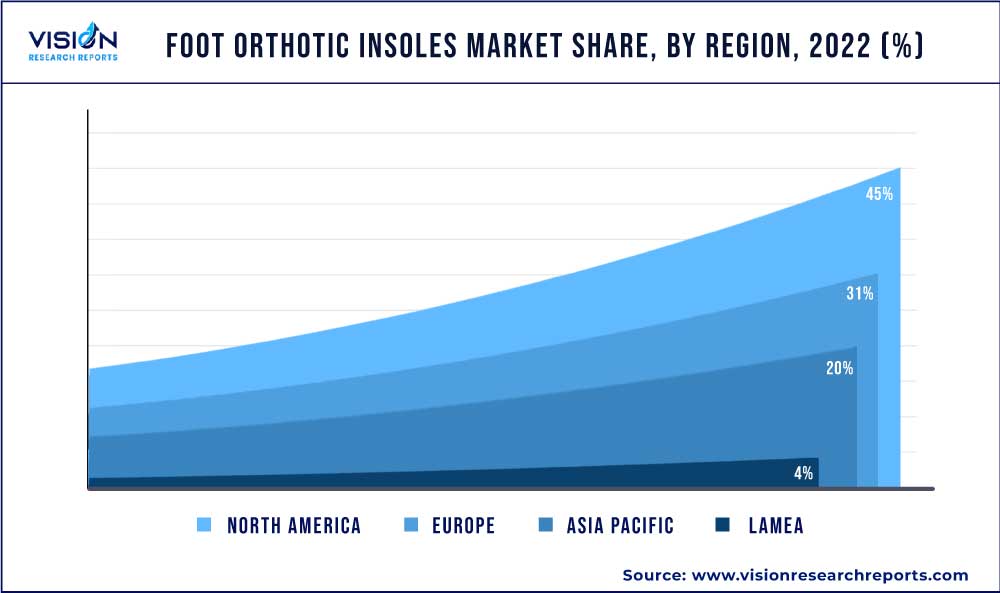The global foot orthotic insoles market was surpassed at USD 3.39 billion in 2022 and is expected to hit around USD 6.69 billion by 2032, growing at a CAGR of 7.04% from 2023 to 2032. The foot orthotic insoles market in the United States was accounted for USD 1.4 billion in 2022.

Key Pointers
Report Scope of the Foot Orthotic Insoles Market
| Report Coverage | Details |
| Revenue Share of North America in 2022 | 45% |
| CAGR of Asia Pacific from 2023 to 2032 | 7.82% |
| Revenue Forecast by 2032 | USD 6.69 billion |
| Growth Rate from 2023 to 2032 | CAGR of 7.04% |
| Base Year | 2022 |
| Forecast Period | 2023 to 2032 |
| Market Analysis (Terms Used) | Value (US$ Million/Billion) or (Volume/Units) |
| Companies Covered | Reckitt Benckiser Group PLC; Hanger Inc.; Ottobock SE & Co. KGaA; Össur hf; Algeo Limited; Bauerfeind AG; Groupe Gorge; Colfax Corporation; Superfeet Worldwide Inc; Materialise NV; Blatchford Group Limited |
The rising geriatric population and a high incidence of diabetes and plantar fasciitis are fueling the growth. According to the United Nations report, in 2019, the world population aged 65 and above reached 702.9 million and this number is expected to grow to 1,548.9 million by 2050. This is expected to create huge opportunities and demand for foot orthotic insoles.
Moreover, technological advancements due to high ongoing investments in R&D are expected to increase the growth potential of the market in the coming years. Moreover, online retailing is anticipated to facilitate consumer reach and product accessibility in the developing region, giving a boost to the industry’s growth over the forecast period.
The COVID-19 pandemic negatively impacted the industry. The pandemic and the associated restrictions and lockdowns affected overall sales of orthotics, including bracing and support products, which are largely driven by injuries, surgeries, and physician appointments. The COVID-19 outbreak impacted all the necessary activities for the sales of foot orthotic insoles. Over the forecast period, the market is expected to return and perform well with the increasing demand from the elderly population and patients.
Increasing demand for custom-made foot orthotics is fueling the growth. These materials are custom-made after a complete evaluation of the foot structure of the user. Tailor-made orthotics have clinically proven advantages over prefabricated ones in terms of better pain management and comfort. There is an increasing demand for 3D-printed orthotics among end-users.
These are thinner as compared to traditional ones, with increased gait efficiency and proprioception, which is boosting the market growth. Also, key players are continuously investing in R&D activities to produce more fit and comfortable insoles using 3D technologies. This is expected to offer increased opportunity in the global foot orthotic insoles market over the forecast period.
The increasing adoption of eco-friendly materials in manufacturing orthotic insoles is opening new avenues for growth. Favorable reimbursement policies in developed countries, growing investments by key industry players, and increased spending on research and development are expected to boost revenue in the coming years.
Many players are also keen on R&D in recycling thermoplastic materials to reduce the carbon footprint to adhere to the various norms and environmental policies. For instance, as published in November 2021, a team at Oxford University Hospital is focusing on significant sustainability improvements while making orthotic insoles and other products. The team has recycled more than 3.8 tons of thermoplastic since 2018.
The industry’s growth is restrained by the lower awareness about the product and treatment for foot pains, mostly in developing nations. In these nations, most of the people with pronation and supination of the foot arch are not aware of the treatment and have limited accessibility in the market. Prices of these foot orthotic insoles also tend to be at higher levels, further restraining the growth.
Material Insights
The thermoplastic segment accounted for a share of 57% in 2022 and is expected to witness a lucrative CAGR of 6.9% from 2023 to 2032. This is attributed to the associated benefits such as comfort and high durability provided by this material. Thermoplastic is a heat-molded form and is increasingly gaining popularity among people who take good care of their feet and those who need therapeutic support while walking. Rigid thermoplastics have limited use for geriatric patients with a high physiological reserve for patients with rigid feet. However, semi-rigid thermoplastic provides better pain tolerance to the geriatric population and is used for individuals suffering from biomechanical foot pain.
The composite carbon fibers segment is expected to grow at a significant CAGR of 7.45% over the forecast period. This is attributed to the increasing popularity of composite carbon fibers in the global market. Composite carbon fiber is known to exhibit high-performance and strong reinforcement polymer, which is a significant characteristic attributed to the increasing growth rate. Moreover, increasing company investment in R&D activities in composite carbon fiber is further expected to drive segmental growth over the forecast period.
Type Insights
The custom-made segment accounted for a share of 55% in 2022. The segment is expected to grow at a CAGR of 6.93% over the forecast period. High consumer preference for custom-made insoles is likely to account for the highest market share. These custom-made insoles provide maximum fit and comfort to patients with specific foot conditions.
The prefabricated segment is anticipated to witness a lucrative CAGR of 7.13% from 2023 to 2032. This is significantly attributed to the increasing consumer awareness about foot orthotic insoles among people with conditions such as plantar fasciitis, and foot arch problems. Increasing product placements and availability at the offline and online retail channels that offer the pre-fabricated foot orthotic insoles is also likely to give a boost and drive the growth of the segment.
Distribution Channel Insights
The hospitals and clinics segment held a share of 40% in 2022. The segment is anticipated to grow at a CAGR of over 7.0% over the forecast period. This is significantly attributed to the fact that a significant share of the consumers is contributed by the patients and their preferences. These patients highly prefer hospitals and clinics for the purchase of foot orthotic insoles. Hospitals and clinics offer highly skilled and experienced personnel as well as proper infrastructure for the treatments and present trustworthy sales channels.

The drug stores segment is expected to exhibit a lucrative CAGR of 7.36% over the forecast period. The growth of the segment is significantly attributed to the expansion of medical and drug stores across the globe, mostly in developing regions. Also, various drug stores are increasingly offering foot orthotic insoles via this sales channel. Also, the second most trustworthy sales channel perceived by consumers tends to be drug stores. Consumer perception and increasing preference for the channel are likely to drive the growth of the segment.
Regional Insights
North America accounted for the largest revenue share in 2022 owing to the rising prevalence of diabetes in this region. In the global foot orthotic insoles, North America accounted for around 45% of revenue share in 2022. In addition, an increase in sports activities drives demand. Technological advancements due to high ongoing investments in R&D are expected to increase growth potential in the coming years.

The focus of the U.S. healthcare system on quality of care and value-based services has led to a favorable environment for foot orthotics. According to the Centers for Disease Control and Prevention, a total of 37.3 million people have diabetes, which accounts for the 11.3% of the U.S. population. Growing prevalence of conditions such as obesity, arthritis, and diabetes further support regional growth.
Asia Pacific is expected to witness a lucrative CAGR of 7.82% over the forecast period, attributed to the factors such as a high target population and technological advancements. In addition, improving health consciousness has benefitted the growth. The demand for prefabricated and custom insoles is significantly high in this region, due to the high incidence of chronic diseases such as musculoskeletal disorders and diabetes. Moreover, the adoption of the western sedentary lifestyle and eating habits are also expected to give rise to chronic diseases such as diabetes. This is likely to create the potential for regional growth.
Foot Orthotic Insoles Market Segmentations:
By Material
By Type
By Distribution Channel
By Regional
Chapter 1. Introduction
1.1. Research Objective
1.2. Scope of the Study
1.3. Definition
Chapter 2. Research Methodology
2.1. Research Approach
2.2. Data Sources
2.3. Assumptions & Limitations
Chapter 3. Executive Summary
3.1. Market Snapshot
Chapter 4. Market Variables and Scope
4.1. Introduction
4.2. Market Classification and Scope
4.3. Industry Value Chain Analysis
4.3.1. Raw Material Procurement Analysis
4.3.2. Sales and Distribution Material Analysis
4.3.3. Downstream Buyer Analysis
Chapter 5. COVID 19 Impact on Foot Orthotic Insoles Market
5.1. COVID-19 Landscape: Foot Orthotic Insoles Industry Impact
5.2. COVID 19 - Impact Assessment for the Industry
5.3. COVID 19 Impact: Global Major Government Policy
5.4. Market Trends and Opportunities in the COVID-19 Landscape
Chapter 6. Market Dynamics Analysis and Trends
6.1. Market Dynamics
6.1.1. Market Drivers
6.1.2. Market Restraints
6.1.3. Market Opportunities
6.2. Porter’s Five Forces Analysis
6.2.1. Bargaining power of suppliers
6.2.2. Bargaining power of buyers
6.2.3. Threat of substitute
6.2.4. Threat of new entrants
6.2.5. Degree of competition
Chapter 7. Competitive Landscape
7.1.1. Company Market Share/Positioning Analysis
7.1.2. Key Strategies Adopted by Players
7.1.3. Vendor Landscape
7.1.3.1. List of Suppliers
7.1.3.2. List of Buyers
Chapter 8. Global Foot Orthotic Insoles Market, By Material
8.1. Foot Orthotic Insoles Market, by Material, 2023-2032
8.1.1 Thermoplastic
8.1.1.1. Market Revenue and Forecast (2020-2032)
8.1.2. Composite Carbon Fiber
8.1.2.1. Market Revenue and Forecast (2020-2032)
8.1.3. Others
8.1.3.1. Market Revenue and Forecast (2020-2032)
Chapter 9. Global Foot Orthotic Insoles Market, By Type
9.1. Foot Orthotic Insoles Market, by Type, 2023-2032
9.1.1. Pre-fabricated
9.1.1.1. Market Revenue and Forecast (2020-2032)
9.1.2. Custom-made
9.1.2.1. Market Revenue and Forecast (2020-2032)
Chapter 10. Global Foot Orthotic Insoles Market, By Distribution Channel
10.1. Foot Orthotic Insoles Market, by Distribution Channel, 2023-2032
10.1.1. Drug Stores
10.1.1.1. Market Revenue and Forecast (2020-2032)
10.1.2. Hospitals & Clinics
10.1.2.1. Market Revenue and Forecast (2020-2032)
10.1.3. Others
10.1.3.1. Market Revenue and Forecast (2020-2032)
Chapter 11. Global Foot Orthotic Insoles Market, Regional Estimates and Trend Forecast
11.1. North America
11.1.1. Market Revenue and Forecast, by Material (2020-2032)
11.1.2. Market Revenue and Forecast, by Type (2020-2032)
11.1.3. Market Revenue and Forecast, by Distribution Channel (2020-2032)
11.1.4. U.S.
11.1.4.1. Market Revenue and Forecast, by Material (2020-2032)
11.1.4.2. Market Revenue and Forecast, by Type (2020-2032)
11.1.4.3. Market Revenue and Forecast, by Distribution Channel (2020-2032)
11.1.5. Rest of North America
11.1.5.1. Market Revenue and Forecast, by Material (2020-2032)
11.1.5.2. Market Revenue and Forecast, by Type (2020-2032)
11.1.5.3. Market Revenue and Forecast, by Distribution Channel (2020-2032)
11.2. Europe
11.2.1. Market Revenue and Forecast, by Material (2020-2032)
11.2.2. Market Revenue and Forecast, by Type (2020-2032)
11.2.3. Market Revenue and Forecast, by Distribution Channel (2020-2032)
11.2.4. UK
11.2.4.1. Market Revenue and Forecast, by Material (2020-2032)
11.2.4.2. Market Revenue and Forecast, by Type (2020-2032)
11.2.4.3. Market Revenue and Forecast, by Distribution Channel (2020-2032)
11.2.5. Germany
11.2.5.1. Market Revenue and Forecast, by Material (2020-2032)
11.2.5.2. Market Revenue and Forecast, by Type (2020-2032)
11.2.5.3. Market Revenue and Forecast, by Distribution Channel (2020-2032)
11.2.6. France
11.2.6.1. Market Revenue and Forecast, by Material (2020-2032)
11.2.6.2. Market Revenue and Forecast, by Type (2020-2032)
11.2.6.3. Market Revenue and Forecast, by Distribution Channel (2020-2032)
11.2.7. Rest of Europe
11.2.7.1. Market Revenue and Forecast, by Material (2020-2032)
11.2.7.2. Market Revenue and Forecast, by Type (2020-2032)
11.2.7.3. Market Revenue and Forecast, by Distribution Channel (2020-2032)
11.3. APAC
11.3.1. Market Revenue and Forecast, by Material (2020-2032)
11.3.2. Market Revenue and Forecast, by Type (2020-2032)
11.3.3. Market Revenue and Forecast, by Distribution Channel (2020-2032)
11.3.4. India
11.3.4.1. Market Revenue and Forecast, by Material (2020-2032)
11.3.4.2. Market Revenue and Forecast, by Type (2020-2032)
11.3.4.3. Market Revenue and Forecast, by Distribution Channel (2020-2032)
11.3.5. China
11.3.5.1. Market Revenue and Forecast, by Material (2020-2032)
11.3.5.2. Market Revenue and Forecast, by Type (2020-2032)
11.3.5.3. Market Revenue and Forecast, by Distribution Channel (2020-2032)
11.3.6. Japan
11.3.6.1. Market Revenue and Forecast, by Material (2020-2032)
11.3.6.2. Market Revenue and Forecast, by Type (2020-2032)
11.3.6.3. Market Revenue and Forecast, by Distribution Channel (2020-2032)
11.3.7. Rest of APAC
11.3.7.1. Market Revenue and Forecast, by Material (2020-2032)
11.3.7.2. Market Revenue and Forecast, by Type (2020-2032)
11.3.7.3. Market Revenue and Forecast, by Distribution Channel (2020-2032)
11.4. MEA
11.4.1. Market Revenue and Forecast, by Material (2020-2032)
11.4.2. Market Revenue and Forecast, by Type (2020-2032)
11.4.3. Market Revenue and Forecast, by Distribution Channel (2020-2032)
11.4.4. GCC
11.4.4.1. Market Revenue and Forecast, by Material (2020-2032)
11.4.4.2. Market Revenue and Forecast, by Type (2020-2032)
11.4.4.3. Market Revenue and Forecast, by Distribution Channel (2020-2032)
11.4.5. North Africa
11.4.5.1. Market Revenue and Forecast, by Material (2020-2032)
11.4.5.2. Market Revenue and Forecast, by Type (2020-2032)
11.4.5.3. Market Revenue and Forecast, by Distribution Channel (2020-2032)
11.4.6. South Africa
11.4.6.1. Market Revenue and Forecast, by Material (2020-2032)
11.4.6.2. Market Revenue and Forecast, by Type (2020-2032)
11.4.6.3. Market Revenue and Forecast, by Distribution Channel (2020-2032)
11.4.7. Rest of MEA
11.4.7.1. Market Revenue and Forecast, by Material (2020-2032)
11.4.7.2. Market Revenue and Forecast, by Type (2020-2032)
11.4.7.3. Market Revenue and Forecast, by Distribution Channel (2020-2032)
11.5. Latin America
11.5.1. Market Revenue and Forecast, by Material (2020-2032)
11.5.2. Market Revenue and Forecast, by Type (2020-2032)
11.5.3. Market Revenue and Forecast, by Distribution Channel (2020-2032)
11.5.4. Brazil
11.5.4.1. Market Revenue and Forecast, by Material (2020-2032)
11.5.4.2. Market Revenue and Forecast, by Type (2020-2032)
11.5.4.3. Market Revenue and Forecast, by Distribution Channel (2020-2032)
11.5.5. Rest of LATAM
11.5.5.1. Market Revenue and Forecast, by Material (2020-2032)
11.5.5.2. Market Revenue and Forecast, by Type (2020-2032)
11.5.5.3. Market Revenue and Forecast, by Distribution Channel (2020-2032)
Chapter 12. Company Profiles
12.1. Reckitt Benckiser Group PLC
12.1.1. Company Overview
12.1.2. Product Offerings
12.1.3. Financial Performance
12.1.4. Recent Initiatives
12.2. PayPal Holdings, Inc.
12.2.1. Company Overview
12.2.2. Hanger Inc.
12.2.3. Financial Performance
12.2.4. Recent Initiatives
12.3. Ottobock SE & Co. KGaA.
12.3.1. Company Overview
12.3.2. Product Offerings
12.3.3. Financial Performance
12.3.4. Recent Initiatives
12.4. Össur hf
12.4.1. Company Overview
12.4.2. Product Offerings
12.4.3. Financial Performance
12.4.4. Recent Initiatives
12.5. Algeo Limited
12.5.1. Company Overview
12.5.2. Product Offerings
12.5.3. Financial Performance
12.5.4. Recent Initiatives
12.6. Bauerfeind AG
12.6.1. Company Overview
12.6.2. Product Offerings
12.6.3. Financial Performance
12.6.4. Recent Initiatives
12.7. Groupe Gorge.
12.7.1. Company Overview
12.7.2. Product Offerings
12.7.3. Financial Performance
12.7.4. Recent Initiatives
12.8. Colfax Corporation
12.8.1. Company Overview
12.8.2. Product Offerings
12.8.3. Financial Performance
12.8.4. Recent Initiatives
12.9. Superfeet Worldwide Inc.
12.9.1. Company Overview
12.9.2. Product Offerings
12.9.3. Financial Performance
12.9.4. Recent Initiatives
12.10. Materialise NV
12.10.1. Company Overview
12.10.2. Product Offerings
12.10.3. Financial Performance
12.10.4. Recent Initiatives
Chapter 13. Research Methodology
13.1. Primary Research
13.2. Secondary Research
13.3. Assumptions
Chapter 14. Appendix
14.1. About Us
14.2. Glossary of Terms
 Cross-segment Market Size and Analysis for
Mentioned Segments
Cross-segment Market Size and Analysis for
Mentioned Segments
 Additional Company Profiles (Upto 5 With No Cost)
Additional Company Profiles (Upto 5 With No Cost)
 Additional Countries (Apart From Mentioned Countries)
Additional Countries (Apart From Mentioned Countries)
 Country/Region-specific Report
Country/Region-specific Report
 Go To Market Strategy
Go To Market Strategy
 Region Specific Market Dynamics
Region Specific Market Dynamics Region Level Market Share
Region Level Market Share Import Export Analysis
Import Export Analysis Production Analysis
Production Analysis Others
Others